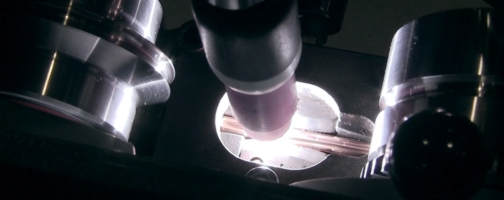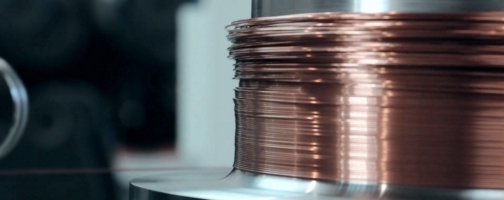Wire bonding is a crucial technique in the production of micro-electronic components. Let’s delve into its process flow, the differences from traditional wire soldering, the required tools and materials as well as the primary applications of this ultrasonic welding process.
Wire bonding process and techniques
Wire bonding is a widely used electrical interconnection technique in electronic device manufacturing, especially for connecting semiconductor chips to their housing or PCB.
As an interconnection technology, wire bonding uses thin metallic bond wires, typically made of gold, aluminum or copper, that are thermally or ultrasonically connected to the chip’s terminals on one end, and to the package’s pins or PCB on the other.
There are at least two types of wire bonding: ball bonding, where a small ball is formed at the wire’s end and then soldered, and wedge bonding, where the metallic wire is directly pressed and joined. The wire then moves to the second soldering point and is finally cut.
By enabling flexible and reliable electrical connections in semiconductors, wire bonding is essential for microelectronics manufacturing, such as processors and sensors.
The differences with traditional wire soldering
Wire bonding technology differs from traditional welding in several ways:
- Size: wire bonding employs extremely thin wires with diameters ranging from a few dozens to a few hundred microns, while traditional soldering wire typically has much larger diameters, around 0.5 – 1 mm.
- Materials: wire bonding uses gold, aluminum or copper wires, whereas traditional soldering wire is typically made from tin-lead alloys.
- Process: wire bonding requires specialized machinery applying controlled heat, pressure and ultrasonics, whereas traditional soldering is done manually or with soldering machines that melt the wire.
- Applications: wire bonding connects chip terminals during manufacturing, while traditional soldering usually joins components already mounted on PCBs.
- Reliability: wire bonding soldering must withstand the stresses of final production processes, demanding high precision and quality; traditional soldering usually doesn’t require such critical standards.
- Costs: wire bonding incurs higher costs due to raw materials and equipment, unlike traditional soldering, which is significantly cheaper.

Applications and bonding wire manufacturing
Wire bond technology is used for various components: memory chips, microprocessors, MEMS sensors, accelerometers, LED chips, and Bluetooth/WiFi radiofrequency devices.
The most common materials for bonding wires production are:
- Gold: preferred for its excellent electrical conductivity, oxidation resistance and ductility, allowing for the creation of very thin wire bonds, mainly used for high-frequency interconnections.
- Aluminum: slightly less conductive than gold but more affordable, aluminum wire bonding is typically used for standard applications at moderate frequencies.
- Copper: cheaper than aluminum and gold, with good conductivity but requiring anti-oxidation coatings. Copper bonding wire is used for low-frequency and power interconnections.
Silver wires are also occasionally used in wire bonding due to their excellent electrical properties, suitable for niche applications requiring maximized conductivity. Other bond wires may be made from various metal alloys of PGMs or with bimetallic coatings.
INVIMEC’s solutions for bonding wire rolling
Wire cold rolling can be a convenient process for bonding wire manufacturing, allowing the production of very thin metallic wires through the controlled pressure from rolling mills, progressively reducing their thickness without compromising their quality.
A precise management of wire rolling achieves extremely reduced diameters, unaltered crystalline structure and high dimensional accuracy: essential features for wire bonding.
INVIMEC produces state-of-the-art wire rolling mills, custom-designed for producing ultra-thin metallic wires for wire bonding processes. Our cold rolling mills for industry are ideal solutions for bonding wire manufacturers, offering an high-quality wire production.
